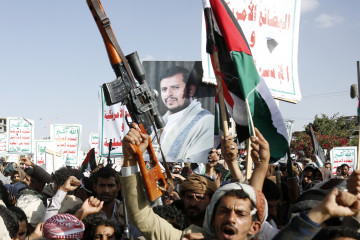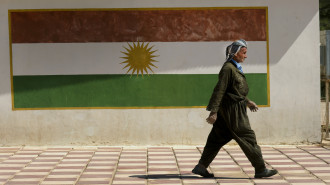

On 19 October, the US Navy successfully intercepted three “land-attack cruise missiles and multiple drones” fired from Yemen in the Red Sea, the Pentagon said, adding they were launched by Houthi forces in Yemen potentially towards targets in Israel.
While the Houthis did not claim responsibility as they have done for past cross-border attacks, the missiles and drones were fired from Houthi-controlled northern Yemen, drawing attention to the potential threats the faction poses.
Houthi leaders have openly threatened to act against Israel in light of its continuing airstrikes on Gaza and the increasing likelihood of a ground invasion. On 17 October, Mohammed Ali Al-Houthi denounced Saudi Arabia for ignoring calls to allow a land, air, and sea passage for Yemeni fighters to move to Palestine.
However, he did claim that the “axis of resistance,” namely Iran, the Houthis, and Hezbollah are discussing so that they can coordinate drone and missile attacks, adding that “all options are possible”.
"Houthi leaders have openly threatened to act against Israel in light of its continuing airstrikes on Gaza and the increasing likelihood of a ground invasion"
Furthermore, as the US expanded its naval presence in the region to support Israel following Hamas’ surprise attack on 7 October, the Houthis threatened to fire missiles and conduct other military operations should Washington intervene.
While the situation is currently paved with uncertainty, it underscores the potential threat posed by the Houthis, as the group has expanded its military capabilities and clout in Yemen. It also illustrates its tightening partnership with Iran, as regional tensions flare up.
Evolution of the Houthi threat
Since capturing the capital Sana’a in September 2014 and triggering the civil war, the Houthi rebels have evolved into a dominant actor in Yemen. Their control over northern Yemen has solidified after withstanding the Saudi Arabia-led coalition's military campaign in March 2015.
As the violence has mostly lulled amid fragile UN-led peace talks and a ceasefire, the Houthis have consolidated their positions.
Aligned with Iran, the Houthis have sought to impose their strict interpretation of Zaydism, a branch of Shia Islam, and replicate North Yemen’s historic Imamate that ruled from 897 until 1962, after which it was displaced by the republican revolution.
Their governance, however, has leaned towards authoritarianism while drawing criticism for its repressive policies towards Yemenis and attempts to seize control of the country.
|
|
The escalation of violence has seen the Houthis express readiness to engage themselves should the US support Israel. Their official stance - evidenced by its slogan “Death to America, Death to Israel, Curse on the Jews, Victory for Islam” - reflects its extremist ideological position.
Amid the current violence, it has actively promoted anti-Israel sentiment within its territories, including organised rallies and influencer-led support for Hamas.
While the Houthis may largely exploit these sentiments to rally public support behind themselves, the faction in recent years has posed more threats to Israel in the Red Sea and has threatened to sabotage Israeli assets there.
As Ahmed El-Deeb noted in the Sana’a Centre for Strategic Studies, the Houthis have expanded control over parts of the Red Sea and have sought to disrupt Israel’s maritime security and trade routes, with the Houthis employing tactics such as mining waters and facilitating arms smuggling.
Meanwhile, Israel has fortified its alliances and participated in naval exercises to safeguard these crucial waterways, underlying that it has increasingly perceived the Houthi threat to its national security interests in the Red Sea.
"As the Houthis ramp up their capabilities for launching attacks, the Red Sea could potentially become another area of conflict"
An anti-Israel axis?
“If one front is opened, all fronts will be opened… They are also ready for Jihad on the shore of Bab al-Mandab and consider the freedom of Jerusalem possible. Syria and Lebanon have their place!” wrote Mahdi Mohammadi, national security advisor to Iran’s parliament, echoing suggestions within Tehran that the Houthis may enter the fray should a wider regional escalation occur.
The growing ties between the Houthis and Tehran have garnered significant attention, spotlighting Iran’s role in supporting the Houthis as it expanded control over Yemen. On the one hand, the Houthis have largely operated autonomously and established their own financial networks, showing the limits of the conventional patron-client relationship narrative on the Tehran-Houthi partnership.
Nevertheless, crucial backing and arms from Tehran have been instrumental for the Houthis, with the Houthis having enhanced their missile capabilities, signalling an elevated risk of cross-border attacks. The faction staged a military parade on 21 September, marking the nine-year anniversary of seizing the capital Sana’a, served as a platform to showcase these bolstered military capabilities.
As military analyst Fabian Hinz observed in the International Institute for Strategic Studies (IISS), one of the Houthis’ new weapons on display - the Toufan missile - demonstrates its growing capabilities, along with a variety of other new missiles.
“The Toufan could have a 1,350–1,950 km range, potentially enough to place Israel within striking distance,” said Hinz. “In the past the Houthis have made threats against [the Israeli cities of] Eilat and Tel Aviv.”
Hinz also noted within its new arsenal, the Houthis also possess the Quds-4 and Quds Z-0 missiles, which can be used against naval targets.
Significantly, Iran’s close Lebanese ally and partner Hezbollah has provided the Houthis with military training, such as in infantry tactics, mine warfare and guided missile operations. Again, even though the Houthis have autonomy in their actions, the relationship has clearly tightened.
And given the relationship has tightened since the last major war between Hezbollah and Israel in 2006, it could be expected that the Houthis would join any battle wherein Hezbollah was involved.
|
|
Risks of an escalation
As the Houthis ramp up their capabilities for launching attacks, the Red Sea could potentially become another area of conflict. Past assaults, like the bold 2021 strike on Saudi Arabia's Aramco facilities, demonstrate the Houthis' expansive reach and the increased threat they pose.
This was further underscored in February 2022 when, concurrent with Israeli President Isaac Herzog’s first visit to the UAE after they established diplomatic ties, the Houthis unleashed drone strikes on Abu Dhabi and Dubai, showing opposition to the growing Arab normalization with Israel.
This posed risks for Yemen’s fragile peace process too, particularly as Saudi Arabia and the UAE have been involved in Yemen’s war against the Houthis.
"Past assaults, like the bold 2021 strike on Saudi Arabia's Aramco facilities, demonstrate the Houthis' expansive reach and the increased threat they pose"
For now, Saudi Arabia has avoided normalisation with Israel and continued its diplomatic rapprochement with Iran amid the violence in Israel-Gaza, as it seeks to prioritise regional stability and its domestic economic transformation.
Any further signs of Riyadh avoiding talks with Israel could prevent a further escalation and threats Iran-backed groups like the Houthis pose.
The extent of the Houthis' ability to target Israel remains unclear. However, they may seek to undermine Israel’s security in the Red Sea while expanding their influence in and around Yemen.
The likelihood of further strikes by the Houthis will also hinge on broader regional developments, particularly given its closeness with Hezbollah and Iran. The violence being limited to Gaza could likely reduce this prospect. Ultimately, while the extent of any escalation may be uncertain, the situation is undoubtedly fraught with risks.
Jonathan Fenton-Harvey is a journalist and researcher who focuses on conflict, geopolitics, and humanitarian issues in the Middle East and North Africa.
Follow him on Twitter: @jfentonharvey





 Follow the Middle East's top stories in English at The New Arab on Google News
Follow the Middle East's top stories in English at The New Arab on Google News


